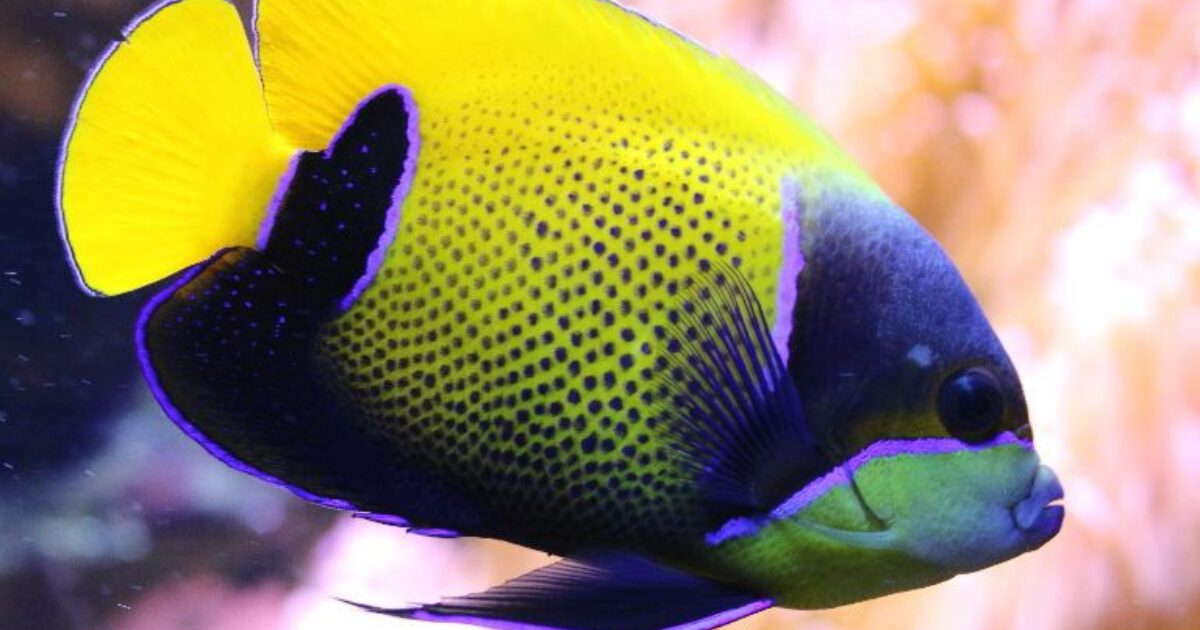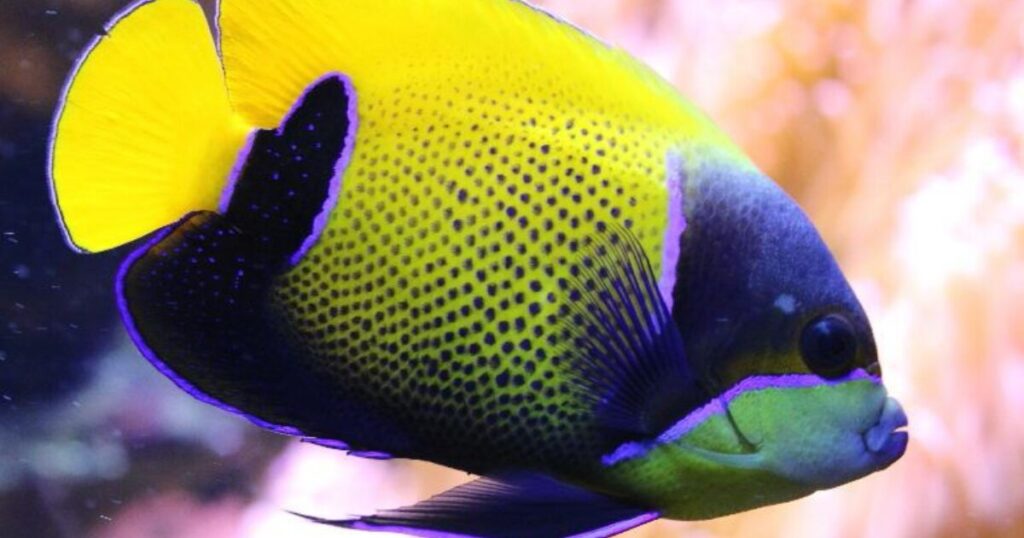
The Majestic Angelfish, also known as the Blue Girdled Angelfish, is a stunning member of the Pomacanthus family. With its vibrant color patterns and graceful presence, it has become a highly sought-after species in the marine aquarium hobby. However, caring for this majestic fish can be quite challenging. In this comprehensive guide, we will explore everything you need to know about Majestic Angelfish care, including tank size requirements, reef compatibility, feeding habits, and more.
Habitat: Distribution and Background.
The Majestic Angelfish, scientifically known as Pomacanthus navarchus, is found in the Indo-Pacific Ocean, ranging from Maldives to Vanuatu and northward to the Yaeyama Islands. This species is usually solitary, but can be found in pairs on the reef. Juveniles of the Blue Girdled Angelfish have a distinct coloration, with black bodies and light blue curved vertical stripes. As they mature, their coloration changes dramatically, with bright yellow to orange bodies and striking deep blue accents.
Appearance and Biology of Pomacanthus Navarchus.
The majestic angelfish has a distinct appearance and growth pattern. Here are some key notes on their biology:
- Scientific Name: Pomacanthus navarchus
- Other Common Names: Blue Girdled Angelfish
- Max Adult Size: 12+ inches
- Coloration: Black, blue and yellow concentric bands. Juveniles have vertical black stripes.
- Native Habitat: Tropical Indo-Pacific reefs.
- Diet: Omnivore that eats sponges, tunicates, algae, coral polyps, small invertebrates.
- Lifespan: 10-15 years with proper care.
- Maturity: Reach full size in 2-3 years. Slow growing.
Understanding their appearance, growth rate, nutritional needs and behavior is key to success.
Juvenile to Adult Transition.
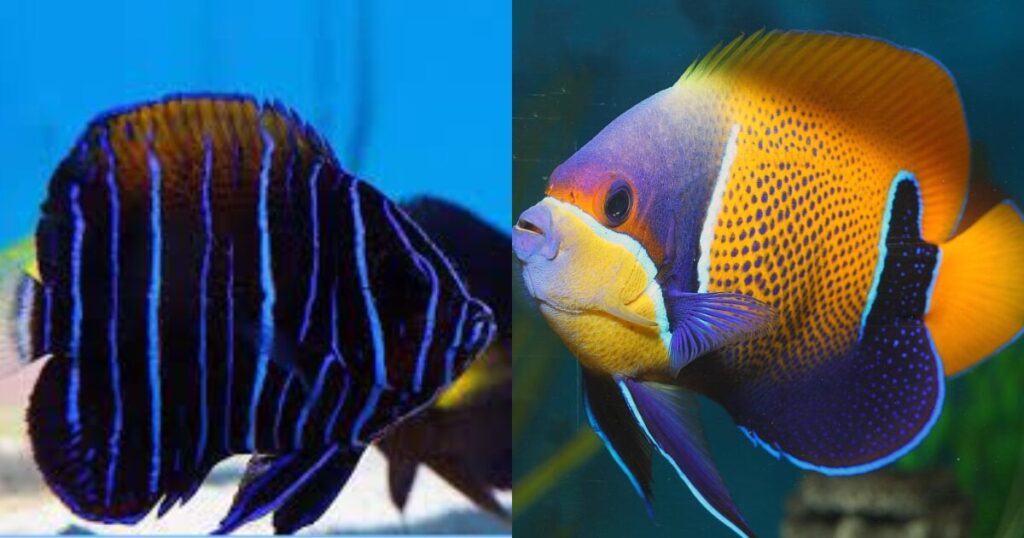
The transition from juvenile majestic angelfish to adult is an intriguing process in the life of a Majestic Angelfish. At around 2 1/2 to 3 inches, the juvenile begins to change color, gradually adopting the vibrant hues of the adult. This slow-growing species typically reaches a maximum size of 12 inches in captivity, making it smaller than other members of the Pomacanthus genus. However, despite its smaller size, the Majestic Angelfish still requires a larger tank due to its territorial nature and the need for ample swimming space.
Blue Girdled Angelfish Or Majestic Angelfish Care Sheet.
Tank Size and Setup
To ensure the well-being of your Blue Girdled Angelfish or Majestic Angelfish, providing a suitable tank environment is crucial.
Keeping majestic angels demands a very large tank to accommodate their substantial adult size. For a single specimen:
- Minimum 125 gallon tank for a 6-7 inch juvenile.
- 180 gallon or larger tank recommended for an adult majestic.
- Avoid overcrowding at all costs – allow plenty of open swimming space.
In terms of setup:
The tank should be well-established, with a mature live rock system that offers plenty of hiding places and overhangs for the angelfish to explore. A reliable protein skimmer is essential for maintaining pristine water conditions, as the Blue Girdled Angelfish is particularly sensitive to high nitrate and nitrite levels.
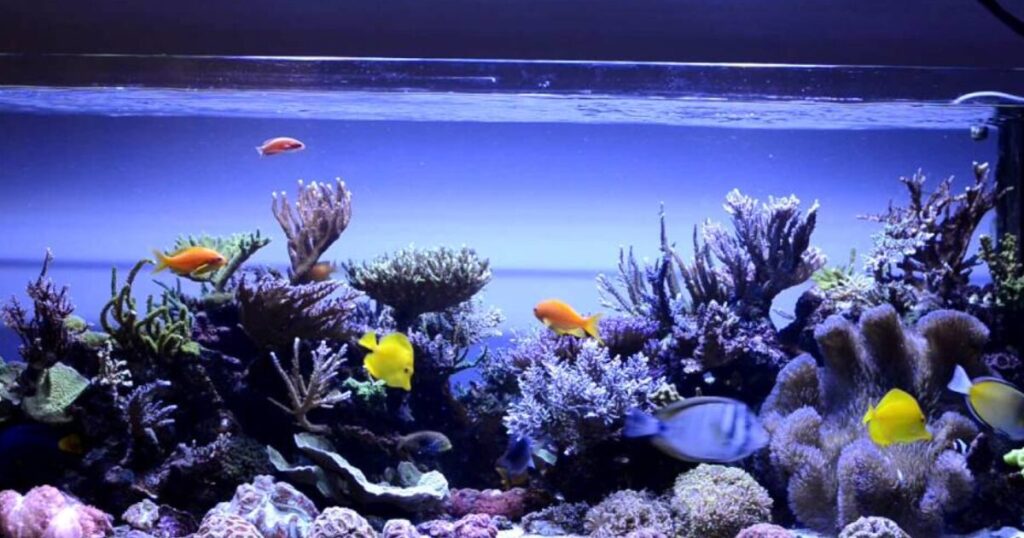
- Incorporate ample live rock structures for grazing, hiding and territory.
- Provide clear sandy spaces for natural foraging behavior.
- Strong water flow rate and high-volume filtration are a must.
- LED lighting supports coral growth if keeping majestics with other fish.
Proper tank size and aquascaping are essential to reducing stress and promoting natural behaviors in captivity. Never keep majestic angels in small cramped tanks.
Water Parameters
Maintaining optimal water parameters is key to the health and longevity of your Majestic Angelfish. The specific gravity should be kept between 1.023-1.025, the temperature should range from 74-78 degrees Fahrenheit, and the pH should be within the range of 8.1-8.4. Additionally, alkalinity levels should be maintained between 8-11.5. It is important to note that this species thrives in reef systems with proper reef-type lighting. Inadequate lighting can lead to conditions such as Marine Head and Lateral Line Erosion, which can negatively impact the health of the angelfish.
Must Have Aquarium Accessories….
Feeding Requirements
As an omnivorous species, the Majestic Angelfish has a varied diet that includes marine algae, angelfish preparations, mysis shrimp, gut-loaded brine shrimp, and Spirulina. In captivity, it is crucial to provide a balanced diet that mimics their natural food sources. Acclimating the angelfish to prepared foods can be challenging, but offering live gut-loaded brine shrimp can entice their feeding response. Regular feeding should be done multiple times a day to ensure their nutritional needs are met.
Juvenile Majestic Angelfish Care.
Caring for juvenile majestic angelfish requires some unique considerations as they mature into adults. Here are some key tips:
Unique Needs of Juveniles
- Can be kept in slightly smaller tanks than adults – minimum 125 gallons.
- Need more frequent feedings of 3-4 small meals daily.
- More sensitive to water quality issues while rapidly growing.
- Often more shy and timid than adult majestic angels.
Transition to Adulthood
As majestic angels mature, you’ll note changes in their:
- Size – Growth starts accelerating around 1 year old.
- Color – Adult patterning will start to emerge as stripes fade.
- Diet – Offer more vegetable matter and algae as they age.
- Behavior – Become bolder and may show territoriality.
Monitor water quality diligently as juvenile majestics rapidly put on size. Increase tank size before they become cramped. Adapt their diet as they mature to keep them vibrant and healthy!
Tank Mates and Social Behavior.
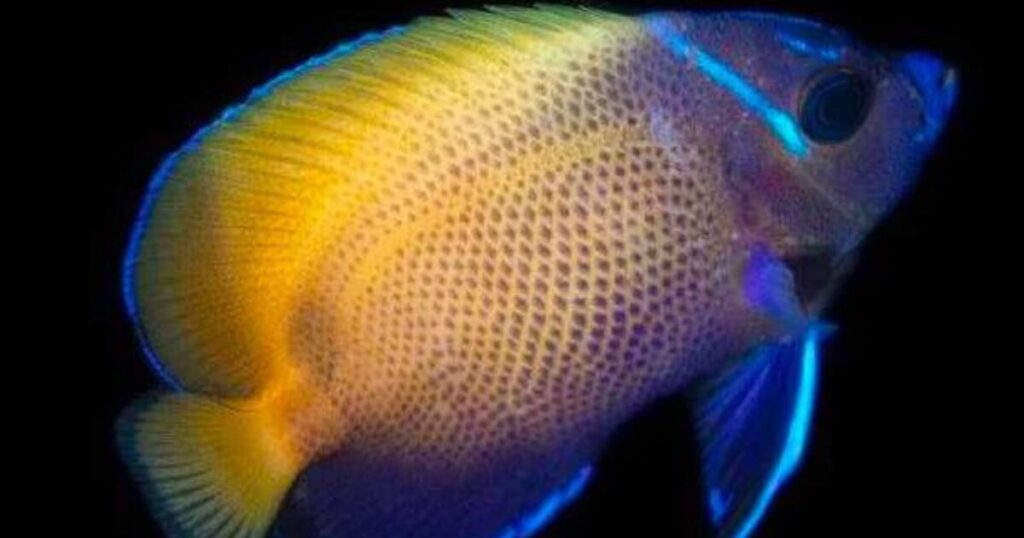
The Majestic Angelfish is generally peaceful towards most other fish, with the exception of larger angelfish and conspecifics. It can be housed with tangs, triggers, clownfish, wrasses, and other semi-aggressive fish. When introducing tank mates, it is advisable to add them all at once to reduce territorial aggression. However, caution should be exercised when considering tank mates such as clams and corals. While some Majestic Angelfish may coexist peacefully with certain coral species, others may exhibit nipping behavior. It is important to monitor their interactions closely and provide ample hiding places for the angelfish’s comfort and security.
Majestic Angelfish Reef Safe Or Not?
The Majestic Angelfish is not considered completely reef safe, but its compatibility with corals depends on the individual fish. Some Majestic Angelfish have been known to coexist peacefully with corals, while others may nip at or even destroy them. Soft corals, anemones, and small polyp stony corals (SPS) are generally more at risk of being targeted. It is recommended to observe the behavior of your Majestic Angelfish closely and make adjustments accordingly to ensure the well-being of both the fish and the corals in your reef tank.
Breeding and Reproduction.
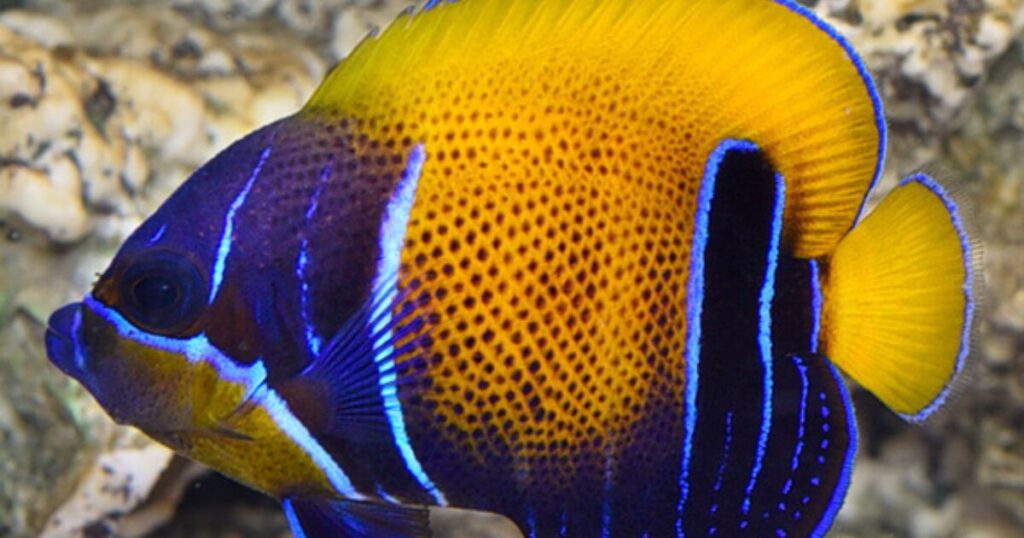
Breeding the Majestic Angelfish in captivity has proven to be a challenge, and successful tank raising has not yet been achieved. This species spawns at dusk, with the male swimming in a circular pattern around the female before releasing sperm to fertilize the eggs. While breeding this angelfish may not be feasible for the average hobbyist, it remains an area of interest for dedicated aquarists.
Availability and Price.
The Majestic Angelfish is considered one of the most desirable species in terms of availability, price, and aesthetic appeal. Due to its striking coloration and relatively smaller size compared to other Pomacanthus angels, it has become a highly sought-after addition to marine aquariums. However, it is important to note that the price of Majestic Angelfish can vary depending on factors such as size, coloration, and availability in the market.
Common Saltwater Angelfish Types…..
Conclusion.
Caring for a Majestic Angelfish can be a rewarding yet challenging endeavor. Their stunning beauty and unique characteristics make them a prized addition to any marine aquarium. By providing the proper tank size, water parameters, and a suitable diet, you can ensure the well-being of your Blue Girdled Angelfish. However, it is essential to be aware of their territorial behavior and potential reef compatibility issues. With the right care and attention, the Majestic Angelfish can thrive and bring a sense of awe-inspiring beauty to your underwater world.
How big do majestic angelfish get?
Majestic angelfish are one of the largest angel species. They can reach over 12 inches in length when fully grown.
What size tank do I need for a majestic angelfish?
A minimum of a 125 gallon tank is recommended for a single majestic angelfish. Adults will need 180 gallons or larger.
Are majestic angelfish reef safe?
No, majestic angels or Blue Girdled Angelfish are not considered reef safe. They will eat soft corals, shrimp, and other reef inhabitants. Keep them in fish-only setups.
Do I need special lighting for a majestic angelfish tank?
Majestics appreciate bright lighting. LED lights that support coral growth are ideal even in fish-only tanks.
How often should I feed my majestic angelfish?
Feed juvenile majestic angels 3-4 times per day. Adults can be fed 2-3 times daily. Soak dried foods before feeding.
What do majestic angelfish eat?
Majestics are omnivores that need a varied diet of meaty and algae-based frozen and dried foods. Supplement with vitamins.
How can I tell a healthy majestic angelfish when buying?
Look for clear eyes, full belly, erect fins, no blemishes. Make sure the fish is active and alert.

